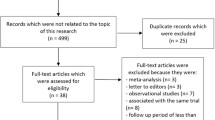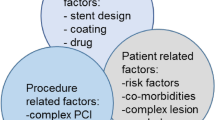Abstract
Over the past decade, coronary stenting has been shown to reduce the rates of angiographic and clinical restenosis compared with conventional balloon angioplasty; however, the use of bare-metal stents remains limited by a high incidence of restenosis, leading to frequent repeat revascularization procedures and substantial economic burden. Antiproliferative drug-eluting stents have recently demonstrated dramatic reductions in in-stent restenosis compared with conventional bare-metal stenting; however, the high cost of drug-eluting stents has raised important questions about the clinical and economic benefits of this ‘disruptive technology’.
Prospective economic evaluations conducted alongside two randomized clinical trials (SIRolImUS-eluting stent in de novo coronary lesions [SIRIUS] trial and the RAndomized study with the sirolimus-eluting VElocity™ balloon-expandable stent in the treatment of patients with de novo native coronary artery Lesions [RAVEL]) comparing drug-eluting stents with conventional bare-metal stenting, as well as decision-analytic models, have examined the economic merit of using drug-eluting stents.
Findings from these studies suggest that although the initial treatment costs with drug-eluting stents are substantially higher, much of the difference in initial costs could be offset by reductions in follow-up costs, mainly due to a reduced requirement for repeat revascularization procedures. Results from these studies show that the cost effectiveness of drug-eluting stents varies considerably with the underlying clinical and angiographic characteristics of the patient population. While drug-eluting stents should be reasonably cost effective for most patients who currently undergo percutaneous coronary intervention (and cost saving for a sizeable minority), for certain subgroups with very low expected clinical restenosis rates (e.g. 5–10%), the routine use of drug-eluting stents may be questioned, at least on economic grounds.
In the future, lower incremental costs for drug-eluting stents should render this technology cost saving for a larger subgroup of patients with PCI, and broaden the ideal target population.


Similar content being viewed by others
Notes
The use of tradenames is for product identification purposes only and does not imply endorsement.
References
Gruntzig AR, Senning A, Siegenthaler WE. Nonoperative dilatation of coronary-artery stenosis: percutaneous transluminal coronary angioplasty. N Engl J Med 1979; 301: 61–8
Fischman DL, Leon MB, Bairn DS, et al. A randomized comparison of coronarystent placement and balloon angioplasty in the treatment of coronary artery disease: Stent Restenosis Study Investigators. N Engl J Med 1994; 331: 496–501
Rankin JM, Spinelli JJ, Carere RG, et al. Improved clinical outcome after widespread use of coronary-artery stenting in Canada. N Engl J Med 1999; 341: 1957–65
Serruys PW, de Jaegere P, Kiemeneij F, et al. A comparison of balloon-expandable-stent implantation with balloon angioplasty in patients with coronary artery disease: Benestent Study Group. N Engl J Med 1994; 331: 489–95
Serruys PW, van Hout B, Bonnier H, et al. Randomised comparison of implantation of heparin-coated stents with balloon angioplasty in selected patients with coronary artery disease (Benestent II). Lancet 1998; 352: 673–81
Laskey WK, Williams DO, Vlachos HA, et al. Changes in the practice of percutaneous coronary intervention: a comparison of enrollment waves in the National Heart, Lung, and Blood Institute (NHLBI) dynamic registry. Am J Cardiol 2001; 87: 964–69
Anderson HV, Shaw RE, Brindis RG, et al. A contemporary overview of percutaneous coronary interventions: The American College of Cardiology-National Cardiovascular Data Registry (ACC-NCDR). J Am Coll Cardiol 2002; 39: 1096–103
Waksman R, Cheneau E, Ajani AE, et al. Intracoronary radiation therapy improves the clinical and angiographic outcomes of diffuse in-stent restenotic lesions: results of the Washington Radiation for In-Stent Restenosis Trial for Long Lesions (Long WRIST) Studies. Circulation 2003; 107: 1744–9
Waksman R, White RL, Chan RC, et al. Intracoronary gamma-radiation therapy after angioplasty inhibits recurrence in patients with in-stent restenosis. Circulation 2000; 101: 2165–71
Cohen DJ, Cosgrove RS, Berezin RH, et al. Cost-effectiveness of gamma radiation for treatment of in-stent restenosis: results from the Gamma-1 trial. Circulation 2002; 106: 691–7
Morice MC. A new era in the treatment of coronary disease? Eur Heart J 2003; 24: 209–11
Morice MC, Serruys PW, Sousa JE, et al. A randomized comparison of a sirolimus-eluting stent with a standard stent for coronary revascularization. N Engl J Med 2002; 346: 1773–80
Holmes Jr DR, Leon MB, Moses JW, et al. One-year follow-up of the SIRIUS study: a randomized study with sirolimus-eluting Bx velocity in the treatment with de novo native coronary artery lesions [abstract]. J Am Coll Cardiol 2003; 41: 32–33A
Schampaert E, Cohen EA, Reeves F, et al. Results from the Canadian multi-center randomized, double-blind study of the sirolimus-eluting stent in the treatment of patients with de novo coronary artery lesions: C-SIRIUS. American College of Cardiology 52th Annual Scientific Session; 2003 Mar 30-Apr 2; Chicago
Schofer J, Schluter M, Gershlick AH, et al. Sirolimus-eluting stents for treatment of patients with long atherosclerotic lesions in small coronary arteries: double-blind, randomised controlled trial (E- SIRIUS). Lancet 2003; 362: 1093–99
Grube E, Silber S, Hauptmann KE, et al. TAXUS I: six- and twelve-month results from a randomized, double-blind trial on a slow-release paclitaxel-eluting stent for de novo coronary lesions. Circulation 2003; 107: 38–42
Colombo A, Drzewiecki J, Banning A, et al. Randomized study to assess the effectiveness of slow- and moderate-release polymer-based paclitaxel-eluting stents for coronary artery lesions. Circulation 2003; 108: 788–94
Park SJ, Shim WH, Ho DS, et al. A paclitaxel-eluting stent for the prevention of coronary restenosis. N Engl J Med 2003; 348: 1537–45
Lemos PA, Serruys PW, Sousa JE. Drug-eluting stents: cost versus clinical benefit. Circulation 2003; 107: 3003–7
O’Neill WW, Leon MB. Drug-eluting stents: costs versus clinical benefit. Circulation 2003; 107: 3008–11
Holmes Jr DR. In-stent restenosis. Rev Cardiovasc Med 2001; 2: 115–9
Fattori R, Piva T. Drug-eluting stents in vascular intervention. Lancet 2003; 361: 247–9
Kuntz RE, Bairn DS. Defining coronary restenosis: newer clinical and angiographic paradigms. Circulation 1993; 88: 1310–23
Jenkins NP, Prendergast BD, Thomas M. Drug eluting coronary stents. BMJ 2002; 325: 1315–6
Heldman AM, Cheng L, Jenkins GM, et al. Paclitaxel stent coating inhibits neointimal hyperplasia at 4 weeks in porcine model of coronary restenosis. Circulation 2001; 103: 2289–95
Hong MK, Kornowski R, Bramwell O, et al. Paclitaxel-coated Gianturco-Roubin II (GR II) stents reduce neointimal hyperplasia in a porcine coronary in-stent restenosis model. Coron Artery Dis 2001; 12: 513–5
Sousa JE, Serruys PW, Costa MA. New frontiers in cardiology: drug-eluting stents (part II). Circulation 2003; 107: 2383–9
Sousa JE, Serruys PW, Costa MA. New frontiers in cardiology: drug-eluting stents (part I). Circulation 2003; 107: 2274–9
Carter AJ, Aggarwal M. Drug delivery systems for stents: are there clinical implications of the ‘polymer’ debate? Am J Drug Deliv 2003; 1: 157–70
O’Neill WW. DELIVER: a randomized comparison of paclitaxel-coated versus metallic stents for treatment of coronary lesions. American College of Cardiology 52th Annual Scientific Session; 2003 Mar 30-Apr2; Chicago
Agency for Healthcare Research and Quality. HCUPnet: healthcare cand utilization project [online]. Available from URL: http://hcup.ahrq.gov/HCUPnet.asp [Accessed 2003 Jun 12]
van Hout BA, Lindeboom WK, Morice MC, et al. Cost-effectiveness of the sirolimus eluting bx-VELOCITY stent: 1-year results [abstract]. Eur Heart J 2002 Aug; 23 Suppl.: 691
Cohen DJ, Taira DA, Berezin R, et al. Cost-effectiveness of coronary stenting in acute myocardial infarction: results from the stent primary angioplasty in myocardial infarction (stent-PAMI) trial. Circulation 2001; 104: 3039–45
Cohen DJ, Bakhai A, Shi C, et al. Cost-effectiveness of sirolimus drug-eluting stents for the treatment of complex coronary stenoses: results from the randomized SIRIUS trial [abstract]. J Am Coll Cardiol 2003; 41: 32A
Cohen DJ, Cosgrove RS, Berezin RH, et al. Cost-effectiveness of eptifibatide in patients undergoing planned coronary stenting. Results from the ESPRIT trial [abstract]. Circulation 2001; 104: 1386–7
Reynolds MR, Neil N, Ho KK, et al. Clinical and economic outcomes of multivessel coronary stenting compared with bypass surgery: a single-center US experience. Am Heart J 2003; 145: 334–42
Clark MA, Bakhai A, Lacey M, et al. The clinical and economic burden of restenosis in the medicare population [abstract]. 4th Scientific Forum on Quality of Care and Outcomes Research in Cardiovascular Disease and Stroke. Washington, DC; 2002 Oct 13–14. Circulation 2002; 106: 76–123E
Kimmel SE, Sauer WH, Brensinger C, et al. Relationship between coronary angioplasty laboratory volume and outcomes after hospital discharge. Am Heart J 2002; 143: 833–40
Cutlip DE, Chauhan MS, Baim DS, et al. Clinical restenosis after coronary stenting: perspectives from multicenter clinical trials. J Am Coll Cardiol 2002; 40: 2082–9
Baim DS, Cutlip DE, Midei M, et al. Final results of a randomized trial comparing the MULTI-LINK stent with the Palmaz-Schatz stent for narrowings in native coronary arteries. Am J Cardiol 2001; 87: 157–62
Gold M, Siegel J, Russel L, et al. Cost-effectiveness in health and medicine. New York: Oxford University Press, 1996
Weinstein MC, Stason WB. Foundations of cost-effectiveness analysis for health and medical practices. N Engl J Med 1977; 296: 716–21
Winkelmayer WC, Weinstein MC, Mittleman MA, et al. Health economic evaluations: the special case of end-stage renal disease treatment. Med Decis Making 2002; 22: 417–30
Goldman L, Gordon DJ, Rifkind BM, et al. Cost and health implications of cholesterol lowering. Circulation 1992; 85: 1960–8
Weintraub WS, Ghazzal ZM, Douglas Jr JS, et al. Long-term clinical follow-up in patients with angiographic restudy after successful angioplasty. Circulation 1993; 87: 831–40
Rinfret S, Grines CL, Cosgrove RS, et al. Quality of life after balloon angioplasty or stenting for acute myocardial infarction: one-year results from the Stent-PAMI trial. J Am Coll Cardiol 2001; 38: 1614–21
Serruys PW, de Jaegere P, Kiemeneij F, et al. A comparison of balloon-expandable-stent implantation with balloon angioplasty in patients with coronary artery disease. Benestent Study Group. N Engl J Med 1994; 331: 489–95
Weaver WD, Reisman MA, Griffin JJ, et al. Optimum percutaneous transluminal coronary angioplasty compared with routine stent strategy trial (OPUS-1): a randomised trial. Lancet 2000; 355: 2199–203
Serruys PW, Unger F, Sousa JE, et al. Comparison of coronary-artery bypass surgery and stenting for the treatment of multivessel disease. N Engl J Med 2001; 344: 1117–24
Cohen DJ, Krumholz HM, Sukin CA, et al. In-hospital and one-year economic outcomes after coronary stenting or balloon angioplasty: results from a randomized clinical trial. Stent Restenosis Study Investigators. Circulation 1995; 92: 2480–7
Seto TB, Cohen DJ. Cost-effectiveness of adjunctive intracoronary brachytherapy for the treatment of in-stent restenosis. Vase Radiother Monitor 2001; 4: 9–15
Lamotte M, Annemas L, De Jong P. Drug-eluting stents in coronary disease: assessments of outcomes and cost-effectiveness [abstract]. Eur Heart J 2002 Aug; 23 Suppl.: 137
Marchetti M, Tarricone R, Lamotte M, et al. Cost-effectiveness and budget impact of the sirolimus-eluting stent in the stent area [abstract]. Value Health 2002; 5: 457
Greenberg D, Cohen DJ. Examining the economic impact of restenosis: implications for the cost-effectiveness of an antiproliferative stent. Z Kardiol 2002; 91: 137–43
Greenberg D, Bakhai A, Neil N, et al. Modeling the impact of patient and lesion characteristics on the cost-effectiveness of drug-eluting stents [abstract]. J Am Coll Cardiol 2003; 41: 538A
Ferreira AC, Peter AA, Salerno TA, et al. Clinical impact of drug-eluting stents in changing referral practices for coronary surgical revascularization in a tertiary care center. Ann Thorac Surg 2003; 75: 485–9
Thompson CA. Medicare to partly cover extra cost of sepsis therapy, drug-eluting stents. Am J Health Syst Pharm 2002; 59: 1816–7
Kong DF, Eisenstein EL, Sketch MH, et al. Economic impact of drug-eluting stents on hospital systems: a disease-state model. Am Heart J. In press
Acknowledgements
Dr Cohen receives grant support from Cordis, Guidant, and Boston Scientific. No financial support was provided for the preparation of this manuscript. The authors have no other conflicts of interest with respect to this manuscript.
Author information
Authors and Affiliations
Corresponding author
Rights and permissions
About this article
Cite this article
Gremberg, D., Bakhai, A. & Cohen, D.J. Do the benefits of new technology outweigh the costs?. Am J Drug Deliv 1, 255–266 (2003). https://doi.org/10.2165/00137696-200301040-00004
Published:
Issue Date:
DOI: https://doi.org/10.2165/00137696-200301040-00004




